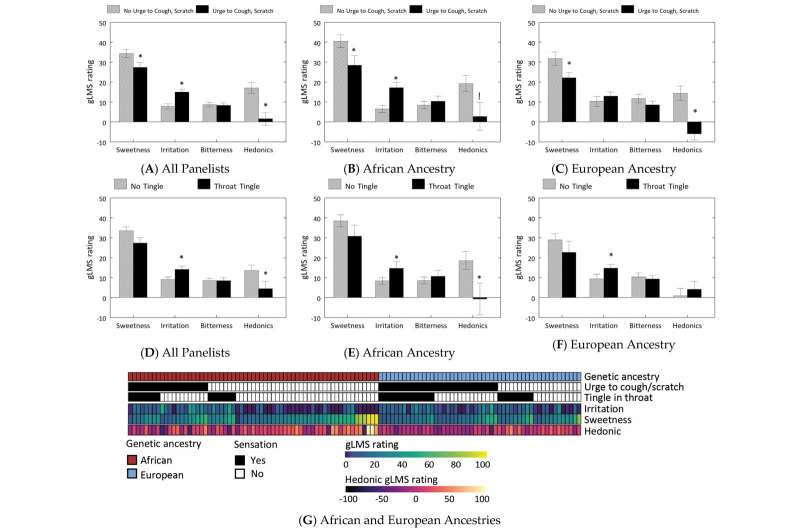This article has been reviewed according to Science X's editorial process and policies. Editors have highlighted the following attributes while ensuring the content's credibility:
fact-checked
peer-reviewed publication
trusted source
proofread
Team discovers markers that can predict how children will tolerate sweetened medicine

Although there are some cultural exceptions to the rule, medicines for children are often given in liquid form that is sweetened to make it taste good. But not every child experiences the same medicine in the same way.
A multidisciplinary research group specializing in pediatrics, genetics, and psychophysics, co-led by Julie A. Mennella, Ph.D., Principal Investigator at the Monell Chemical Senses Center, has identified wide variation in the sensory perception of a pediatric formulation of ibuprofen—some that were tied to genetic ancestry, and some that were not. These findings indicate that a range of factors come into play in determining how a medicine tastes to an individual.
The team's work, recently published in the International Journal of Molecular Sciences, is the first in a planned series of studies that will look at variation in the taste of medicines.
"Taste is personal and determining how individuals differ and why is critical to understanding medication adherence and personal risks," said Mennella.
Bitter taste and irritating sensations in the throat are the top reasons for non-compliance, as a child (or adult) is less likely to ingest a medicine that is unpleasant (or tastes bad). However, if a child finds the medicine bottle uncapped and finds it tastes sweet like candy, they may ingest too much. Discovering how individuals differ in sensory perception is especially key when it comes to liquid ibuprofen, which accounts for many unintentional poison exposures among children under the age of six years in the US, according to the U.S. Poison Centers.
"Sweetening medicines like ibuprofen is a delicate balance between having it taste good enough that kids take it, but bitter enough that should they get unguarded access to it, it's irritating enough that they stop drinking it and don't poison themselves," said Mennella.
"We found genetic markers, both ancestry-related and independent of it, that could predict if someone would find a medication irritating or pleasantly sweet. If we get to the point of tailor-making medications in the future, knowing these associations could help us design taste specifically for each child in the not-so-distant future," she continued.
The study included 154 adult panelists from Philadelphia, who represented the diversity of their city. According to a genome-wide association study, 63 had African ancestry, 51 European, 13 South Asian, seven East Asian, and seven American. They underwent training in sensory methods and then rated the sweetness, irritation, bitterness, and palatability of a pediatric formulation of a berry-flavored ibuprofen after swallowing, and also after just tasting it without swallowing.
Researchers found that panelists of African genetic ancestry had fewer chemesthetic sensations such as tingling or an urge to cough, rated the medicine as tasting sweeter and more palatable than those of European genetic ancestry. Researchers also found a novel association between the TRPA1rs1198875 genetic variation and tingling sensations, independent of ancestry. This is significant, as TRPA1 is a family of neuron receptors that are involved in sensory neural response to a variety of chemical irritants found in foodstuff and other medicines.
Discovering both an ancestry-related link and non-ancestry-related genetic variation to taste and irritation perception shows that who perceives a medicine as palatable or not is a complicated picture and must consider a variety of factors.
This first study was conducted with adults because the sensory measures were complex and included several hour-long test sessions. That does not mean future tests should not include children, Mennella said, adding that this is just the first in a line of studies on the taste of pediatric medicines, and methods must be developed to measure sensory irritation in children.
"This is a small study, but it is the first step in showing how research on diverse populations is needed to be able to unravel the genetic, cultural, dietary, and developmental paths that underlie medicine adherence and also risk for poisoning," said Mennella. "It's looking at both sides of the same, very important coin."
Findings from this research will affect how sensory tests can be designed in the future. Since participants did both swallow and sip-and-spit tests, the team was able to determine that just tasting medicine allowed predictions and perceptions after swallowing, which could simplify future studies in different age groups. Other studies as part of this National Institutes of Health grant are ongoing, including determining the variation and acceptance of medicines in children.
Co-authors are co-first author Mengyuan Kan, University of Pennsylvania (Penn); Joel D. Mainland, Monell Chemical Sense Center; Luis R. Saraiva, Sidra Medicine, Qatar and Monell Chemical Senses Center; Elizabeth D. Lowenthal, Penn (co-PI of grant); Blanca E. Himes, Penn; and M. Yanina Pepino, University of Illinois at Urbana-Champaign.
More information: Julie A. Mennella et al, Genetic Variation and Sensory Perception of a Pediatric Formulation of Ibuprofen: Can a Medicine Taste Too Good for Some?, International Journal of Molecular Sciences (2023). DOI: 10.3390/ijms241713050















